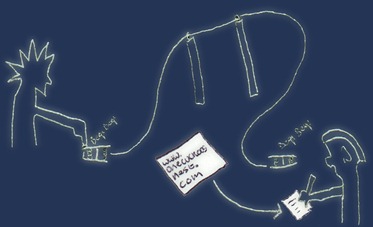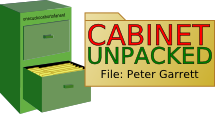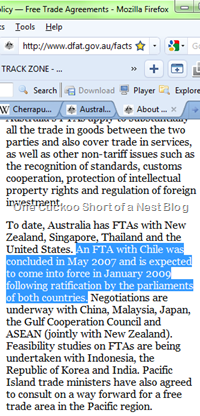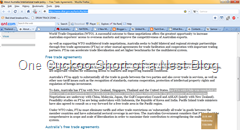Monday, November 30, 2009
News: Hockey Announces Leadership Challenge, Abbott Withdraws
Friday, November 27, 2009
The Development of the CPRS – Part Six: Emission Targets Around the World
The Labor Government’s targets in its Carbon Pollution Reduction Scheme have been described as being too little by some and too much by others given Australia’s small contribution to global emissions. Some Liberal party members have commented that the targets are premature and at the moment “unilateral”, and that the CPRS legislation should be deferred until after the Copenhagen Summit next month.
But at the moment, what are the proposed emission reduction targets of the other countries, states and organisations around the world? How do these compare with Australia’s targets? The below grid compiled by this blog’s author compares some (20) of the world’s targets, including draft legislation for the US state of California, which has already created a scheme ahead of the US federal government. California’s program is expected to begin in 2012. Also of interest is new Zealand’s scheme, which has already passed its parliament.
| By 2012 | By 2020 | Per Capita By 2020 | By 2050 | |
| Australia | 108% of 2000 levels. (2013 is 107% of 2000 levels.) | 4-14% below 1990 levels, or 25% with an international agreement. | 34-41% below 1990 levels. | 60% below 1990 levels. |
| California (US State) | -- | Equal to/lower than 1990 levels. (Guaranteed – part of state law) | -- | -- |
| Canada | 6% below 1990 levels when Kyoto was ratified, however present minority Government opposes this and says it will not meet this target. | KYOTOplus: 25% decrease on 1990 levels. | -- | -- |
| China | IN 2010: 20% cut in energy intensity on 2005 levels. Reduce energy usage by one fifth. | Carbon dioxide emissions cut by 40-45%. (15% renewable energy) | -- | ((Not yet committed to a half reduction in world emissions by 2050 |
| Denmark | -- | 20% reduction on 1990 levels. | -- | -- |
| European Union | -- | 20-30% below 1990 levels | 24-34% below 1990 levels | 60-80% below 1990 levels. |
| France | Already met Kyoto targets. | 30% reduction on 1990 levels. (20% renewable energy.) | -- | “Fourfold” reduction on 1990 levels. |
| Germany | 21% reduction on 1990 levels. (Already met.) | 36% below 1990 levels. | -- | -- |
| Japan | Aiming to be in line with Kyoto. | -- | -- | -- |
| Kyoto Protocol | 5.2% of 1990 levels. This is a different amount for each signatory. | -- | -- | -- |
| New Zealand | -- | 10-20% below 1990 levels. | -- | -- |
| Norway | -- | 40% below 1990 levels. | -- | -- |
| Regional Greenhou-se Gas Initiative (US states and provinces) | -- | 10% below 1990 levels. | -- | -- |
| (Scotland – under jurisdiction of UK parliament) | -- | (40% of energy from renewable sources. Other targets are set by UK.) | -- | -- |
| South Korea | -- | 30% lower than predicted (4% lower than 2005 levels.) | -- | (20% renewable energy.) |
| Sweden | Already met Kyoto targets. | 20% below 1990 levels. | -- | -- |
| Switzerland | -- | 20% reduction on 1990 levels. | -- | -- |
| United Kingdom | 20% less on 1990 levels, however acknowledges that it may fall 4% short. Government estate carbon neutral. | 26-32% below 1990 levels (Old info?) | 24-34% below 1990 levels. (Old info?) | 80% below 1990 levels/60% decrease on present levels. |
| United States (Proposed before Obama became President) | -- | 1990 levels. 17% reduction in industry on 2005 levels. | 25% below 1990 levels. | 80% below 1990 levels. 83% reduction in industry on 2005 levels. |
| Western Climate Initiative (US State alliance) | -- | 15% lower than 2005 levels. | -- | -- |
Missed any? Please post a response with your addition.
News: Liberal Party Set to Split?
This comparison is grounded by the spate of resignations of Coalition members from Malcolm Turnbull’s front bench after he survived a leadership spill two days ago. At present 12 members have relinquished their positions.
The Liberal party has been divided since Turnbull’s decision to support the Rudd Government’s Carbon Pollution Reduction Scheme (CPRS). Turnbull has vigorously defended his position as leader, lashing out at those who don’t support his decision.
Former Shadow Minister for Health and Ageing Tony Abbott and Shadow Treasurer Joe Hockey are favourites to take the leadership of the party, however Hockey has said that he will only run if Turnbull has resigned. Hockey has frequently stated that he supports Turnbull,
The party is bitterly divided over the human contribution to global warming, with the leader of the Liberals in the Senate Nick Minchin not sharing Turnbull’s views that action needs to be taken. Minchin was one of the twelve to resign from a front bench position.
Could this be the sign of an imminent split in the party? As several members plan a second leadership spill it may not be long until we know. As it is often said a week is a long time in politics, and this weekend may not hold up either.
Wednesday, November 25, 2009
News: Malcolm Turnbull Retains Liberal Opposition Leadership
At about 1:18PM today the results of the vote on the Liberal party leadership spill were announced.
A secret ballot was taken in a meeting called by Turnbull himself in response to growing Liberal party disharmony over his decision that the party will support the Government’s Carbon Pollution Reduction Scheme (CPRS). Some Liberal MPs argued that his call was premature and not in the party’s interest.
Malcolm Turnbull has retained his position as leader of the Liberal party by a margin of 13 votes, with a count of 48 votes to 35 in his favour.
This support means that the CPRS may have a chance of passing through the Senate without the support of the Greens, Family First or Nick Xenophon. However, the stance of some Liberal senators prior to the vote suggests that it may still not have the support of the whole Liberal party.
Posted: 1:30PM AEST on the 25/11/2009
Tuesday, November 24, 2009
News: No Longer the Wong Way: The Results of the Liberal-Labor Party Negotiations Released
Today’s Media Release from the Department of Climate Change outlines the areas in which changes have been proposed. Included amongst these propositions is the Government’s previously announced exclusion of agriculture from the CPRS. The details of the proposed changes document also supplied by the Department of Climate Change says that this exclusion will be “indefinite” and the bill will “explicitly exclude agriculture”. This means that any change to this part of the passed CPRS legislation will need to be voted on by the parliament of the day.
The changes also include $1.1 billion for a Transitional Electricity Cost Assistance Program, designed to assist medium to large businesses with the increased electricity costs. An additional $4 billion is also proposed for the Electricity Sector Adjustment Scheme (ESAS) making the total investment in this area $7.3 billion. The ESAS is designed to lessen the financial shock of the CPRS on fossil-fuel powered electricity generators such as coal powered power stations. Coal fuelled power stations will also be receiving a further $750 million in “transitional assistance” over five years, making the total transitional assistance for the coal industry come to $1.5 billion. $270 million for the Coal Mine Abatement Fund has also been proposed.
The changes also suggest including voluntary household action in the goal of the CPRS, and the details mention that an assistance package has been designed for low- and middle-income households. The carbon price estimate has also been lowered by $3 to $26 per tonne in 2012-2013 due to the strong Australian dollar, which will reduce the cost of goods and services. The media release says that “voluntary action by households will now allow Australia to go beyond our 2020 emissions reduction target.”
The details mention that eligible Liquified Natural Gas (LNG) producers will receive free permits.
The media release also describes making the Global Recession Buffer for affected industries permanent, meaning that eligible industries for 60 and 90 per cent assistance will have a 10 per cent and 5 per cent buffer respectively to ensure sufficient assistance.
The media release explains that with these amendments, Australia will still be able to achieve its “ambitious” unconditional target of a 5 per cent reduction of greenhouse gas emissions on 2000 levels by 2020. It also argues that the “deal” is economically “responsible”.
The media release closes with a plea to the Liberal Party. “We call on the Opposition to support this negotiated package and ensure a vote on this package before Parliament rises this week” - a timetable which many Liberal party members may still not agree with.
www.onecuckoosnest.com
Flying up in the world! No longer weighed down by the .blogspot address, One Cuckoo Short of a Nest can now be accessed through the domain www.onecuckoosnest.com.
The OCSN feed has not yet been migrated to the new domain and can still be accessed from http://feeds.feedburner.com/OneCuckoo.
Links pointing to http://onecuckoosnest.blogspot.com will redirect to the new address.
Sunday, November 22, 2009
Cabinet Unpacked: Peter Garrett
This post looks at Midnight Oil Front Man-turn-Labor party MP Peter Garrett.
| Portfolio: Minister for the Environment, Heritage and the Arts | Held position since: 2007 |
| Constituency: Kingsford Smith (NSW) | In Parliament since: 2004 |
| 21st Minister for the Environment, Heritage and the Arts | House: House of Representatives |
Midnight Oil was famous for its political statements, including performing at the 2000 Sydney Olympics wearing clothes opposing former Prime Minister John Howard’s refusal to apologise to the Aboriginal Stolen Generation.
Garrett first tried to become involved in politics in 1984, when he stood for a Senate position for the Nuclear Disarmament Party. He was not elected.
Garrett joined the Australian Labor Party in 2004, winning the Labor safe seat of Kingsford Smith and increased the Labor majority in the electorate. According to the Australian Electoral Commission website, Garrett also received a 4.24% swing towards him in the 2007 election.
As a shadow minister in the Labor Opposition between 2004 and 2007, Garrett held the portfolio of Shadow Minister for Climate Change, Environment, Heritage and the Arts. When the Labor party gained power in the 2007 election, Garrett lost the Climate Change portfolio to Penny Wong.
Garrett has been commented as back-flipping on his opposition to Uranium mining and the Pine Gap US-Australian Defence Facility. Garratt has explained that he will fight these issues internally, however will accept the Labor caucus’ vote. Garrett told 2UE radio broadcaster Steve Price that the Labor party would change its policies if elected, possibly a reason why he lost the climate change portfolio. Garrett described this as a “short and jocular conversation.” Greens leader Bob Brown described Garrett as a “sell out”, saying that “the Labor Party machine has taken him over and turned him into an anti-green campaigner."
(Most information from: Source)
- Environmental issues (largely excluding Climate Change): This is part of his job as environment minister.
- Arts related: All forms of art including music, dance and dramatic arts. This includes funding and recognition of each.
- Heritage related: Maintaining, protecting and educating about Australia’s history.
- $32 million in funding for “non-lethal whale research” in response to Japan’s deployment of a fleet of whaling ships heading for the Southern Ocean. (19th November 2009)
- Recognition of Dr Ron Radford for “his selection as a recipient of the French Honour, L'Ordre des Arts et Lettres.” (19th November 2009)
- Giving $439,928 in funding toward protecting Australia’s underwater cultural heritage. (20th November 2009)
- Commissioning and acting on reports regarding environmental issues, such as the Montara oil leak. (30th October 2009)
![]()
Peter Garrett has not yet made any pivotal speeches since becoming a politician, however his maiden speech to the House of Representatives marks his entry to Parliament. A transcript of this can be accessed from the Parliament of Australia website.
- "This separation is a principle I firmly believe in, while also believing that someone's personal values should and do inform one's day to day thought processes and decision-making." - Garrett explaining the influence of his Christian beliefs on his actions and opinions with reference to the separation of church and state. (From: http://www.petergarrett.com.au/235.aspx)
- “Team player.” - Garrett describing how he will stand for his beliefs in the party room, however will accept the vote of caucus.
- "Short and jocular." - How Garrett described his conversation with 2UE broadcaster Steve Price in which he said the Labor party would change its policies once it gains power.
Saturday, November 21, 2009
IT News: Wikipedia Beta Introduces New Add to Watchlist Shortcut
It may not sound much, but the Wikipedia Beta now includes a new shortcut in the interface of the popular online reference.
The shortcut allows users to quickly add a page to or remove one from their “watchlist”, a process which used to be well hidden and most easily found during editing.
This addition to the already radically overhauled interface reinforces the website’s aim of becoming more accessible.
The watchlist function notifies users when a page has been edited.
To try the beta for yourself, you need a Wikipedia account (free from the website). Once logged in, select “Try Beta” from the links at the top right of the screen and you’re in.
Friday, November 20, 2009
How To: Easily Create a Font for Free
Fonts. You’re looking at one now. Look around your screen and chances are you will find at least one more, but have you ever wanted something different? Something unique to you? Well, what could be more unique than your very own, home made font!
To make a good font easily, you need two free programs:
- Inkscape
This is a cross-platform vector image editor (that is, images that can be resized without pixilation) that can export in the SVG format. Other similar programs may also work. - FontForge
This is a cross-platform font creator. It is native to Linux, however there are ports (versions) which work well on Windows.
Once you have downloaded and installed these two applications, you can begin.
- Firstly, you need to get creative in Inkscape and create your font. Shapes can be created with the pen tool and the circle, square and polygon tools. Other tools may not export to FontForge well if at all. If you want your glyph (your individual font image) to have a
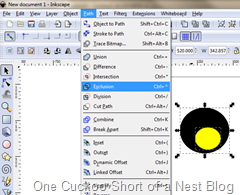 transparent section within an opaque area, create the inner shape over the outer shape, select both and navigate to “Path>Exclusion”. This will make the middle transparent.
transparent section within an opaque area, create the inner shape over the outer shape, select both and navigate to “Path>Exclusion”. This will make the middle transparent. - Save each glyph as a separate SVG file under an appropriate name.
 Open font forge and at the “Open Font” menu, select “New”. You will be presented with a table of empty glyph positions.
Open font forge and at the “Open Font” menu, select “New”. You will be presented with a table of empty glyph positions. - Double-click on the glyph you wish to insert your image into.
- A rather daunting screen will appear (if the grid one wasn’t already scary enough!), but it is easier to use than it looks.
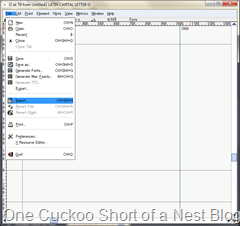 If you want to create your glyph from scratch with the FontForge toolbox (this is NOT what is being explored in this tutorial) you can do so now. However, as we have already created the glyph in Inkscape, simply select “File>Import”, choose “SVG” from the “Format” drop-down and navigate to and select the file made in Inkscape.
If you want to create your glyph from scratch with the FontForge toolbox (this is NOT what is being explored in this tutorial) you can do so now. However, as we have already created the glyph in Inkscape, simply select “File>Import”, choose “SVG” from the “Format” drop-down and navigate to and select the file made in Inkscape. - Now we need to resize the imported image. Click and drag a box around the
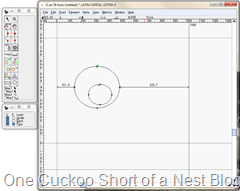 glyph with the “Pointer” tool. Now either move the body of the image to the first bottom line in the guideline from the centre, or click “Scale the Selection” from the Toolbox (7th button down on the left) and resize it to the size you want it to be. Holding down the Shift key on the keyboard will help to keep the image in shape. At the end, the body of the glyph should line up with the first line, with any tail overlapping toward the second line. This second line should not be passed.
glyph with the “Pointer” tool. Now either move the body of the image to the first bottom line in the guideline from the centre, or click “Scale the Selection” from the Toolbox (7th button down on the left) and resize it to the size you want it to be. Holding down the Shift key on the keyboard will help to keep the image in shape. At the end, the body of the glyph should line up with the first line, with any tail overlapping toward the second line. This second line should not be passed. - Now you can adjust any point (or points) in the glyph that you are not happy with. Using the “Pointer” tool, select the nodes in the glyph and move or adjust them as you feel fit.
- Now the glyph needs to be finished by adjusting the
 margin between the edge of the glyph and the right and left sides of the bounding box. Usually an equal distance on each side works well. Simply select the whole glyph (as we did before) and nudge it left or right using the corresponding keys on the keyboard until the left margin is as large as you want it to be. Deselect the glyph and then drag the bounding box line on the right to be roughly the same as that on the left.
margin between the edge of the glyph and the right and left sides of the bounding box. Usually an equal distance on each side works well. Simply select the whole glyph (as we did before) and nudge it left or right using the corresponding keys on the keyboard until the left margin is as large as you want it to be. Deselect the glyph and then drag the bounding box line on the right to be roughly the same as that on the left. - Repeat for each glyph. Not all glyphs need to be filled, however it is recommended that most letters and numbers are created.
- When you have completed your font, on the grid screen select "Element>Font Info”. Here you set your font’s name. It’s acceptable to enter the same name in each of these, just make sure it is one that is unique to the font to avoid conflicts.

- Export the font! To do this, select “File>Generate
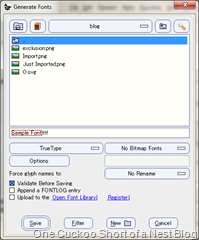 Fonts”. Select “True Type” from the first drop down menu and, if you choose to, select “upload it to the Open Font Library”. If you decide to upload your font to this resource, make sure you read the licensing requirements of this service as it makes your font open source. Click “Save” and accept the error dialogues and your font should work fine.
Fonts”. Select “True Type” from the first drop down menu and, if you choose to, select “upload it to the Open Font Library”. If you decide to upload your font to this resource, make sure you read the licensing requirements of this service as it makes your font open source. Click “Save” and accept the error dialogues and your font should work fine. - There isn’t one! You have finally finished! A long process but well worth it.
On A Friday: Chile Called and They Want Their Trade Back
Australia has many Free Trade Agreements (FTA) with countries around the world, including New Zealand, Singapore and the United States. Australia also has an FTA with Chile, well, if the DFAT website is to be believed, sort of.
The DFAT, or Department of Foreign Affairs and Trade, is the Federal body which deals with matters regarding trade and other foreign relations such as foreign aid. The main website addressing Australia’s FTAs only mentions the Australia-Chile FTA as being under negotiation, and “expected to come into force in January 2009”.
Fortunately, DFAT has a page on the Australia-Chile FTA which is up to date despite this main page being old. I’ll overlook the fact that the FTA came into effect two months later than expected!
I discovered this on the 7th of October this year and promptly emailed DFAT, however at time of writing (over a month and a half later) this vital piece of information has still not been updated. A copy of the email is below:
To whom it may concern,
I have found a small discrepancy on your page regarding Free Trade Agreements (http://www.dfat.gov.au/facts/fta.html). In the third paragraph of the section entitled ‘Free trade agreements’ on this page, the section regarding the Chile-Australia FTA reads as follows: “An FTA with Chile was concluded in May 2007 and is expected to come into force in January 2009 following ratification by the parliaments of both countries.”
This information is superseded by information on another DFAT page which reads as follows: “The Australia-Chile FTA entered into force on 6 March 2009.” (http://www.dfat.gov.au/GEO/chile/fta/index.html)
I hope that this email can be of assistance in fixing this error,
William Kulich
I hope this is fixed soon – it is a little embarrassing!
Monday, November 16, 2009
On A Monday: As Time Goes By (Bye Bye Rove, Hey Hey Daryl)
This is On A Friday in disguise. Yesterday marked the final episode of the Network Ten program ‘Rove’ (previously ‘Rove Live’, and on Channel 31 ‘The Loft Live’). Rove started on the Nine Network in 1999, the same year that Nine program Hey Hey It’s Saturday was axed.
This was no coincidence as it is known that then-Nine Executive Kerry Packer preferred Rove, and cancelled the still successful Hey Hey in favour of the new program. Rove soon moved to Network Ten.
Now, with the final Episode of Rove having aired and Hey Hey set to return for a new season in 2010, the irony sets in. Apart from a brief overlap in 1999, the two shows have never aired at the same time yet there hasn’t been a year without either since 1971!
Rove and Hey Hey – Mutually exclusive.
Sunday, November 15, 2009
The Development of the CPRS – Part Five: Alternative Parliamentary Emission Reduction Targets Compared
Who are the Players?
The groups which have the most say in the passing of the Carbon Pollution Reduction Scheme (CPRS) are, ultimately, the Members of Parliament and Senators of the Australian Federal Parliament. The parties represented in the House of Representatives are the Labor Party (83 Seats) and the Liberal/National Coalition (65 Seats in total – 55 Liberal, 10 National). In the Senate the composition is the Labor party (32 Seats), the Liberal/National Coalition (37 Seats), The Australian Greens (5 Seats), Family First (1 Seat) and South Australian Independent Senator Nick Xenophon.
What are their Targets?
| PARTY | 2020 Targets | 2020 per capita reduction | 2050 Targets |
| Labor | 5–15 per cent below 2000 levels | 27–34 per cent below 2000 levels | 60 per cent below 2000 levels |
| Liberal | Reduce carbon emissions by 150 million tonnes – 10 per cent on 2000 levels. | -- | -- |
| National | Yet to formulate a policy. | -- | -- |
| Greens | minimum of 40% reduction on 1990 levels by 2020 | -- | Net 0 emissions by 2050 at latest. |
| Family First | N/A* | N/A* | N/A* |
| Xenophon | both Xenophon and the Liberal party commissioned a report from Frontier Economics, hence the targets are the same. | -- | -- |
*Family First Senator Steve Fielding does not believe in Global Warming, thus there are no targets in this table.
How each party intends reaching these targets will be explored in a later instalment.
Cabinet Unpacked: Kevin Rudd
 Dissecting Cabinet: where to start!? At the top of course. This post deals with the big one; the Prime Minister, Kevin Rudd.
Dissecting Cabinet: where to start!? At the top of course. This post deals with the big one; the Prime Minister, Kevin Rudd.
| Portfolio: Prime Minister | Held position since: 2007 |
| Constituency: Griffith (Qld) | In Parliament since: 1998 |
| 26th Prime Minister of Australia | 19th Leader of the Australian Labor Party |
Kevin Rudd is Australia’s Prime Minister. He gained office in the 2007 Federal election in a landslide victory over former Liberal Prime Minister John Howard. This victory was described as a “Ruddslide” by the media.
Rudd has led the Australian Labor Party since December 2006 when he and Julia Gillard challenged then opposition leader Kim Beasley and deputy Jenny Macklin in a party vote. Kevin Rudd shot to popularity as the newer, more accessible alternative to John Howard, running with the campaign slogan of “Kevin07”.
In the Labor opposition in 2001 Kevin Rudd was appointed Shadow Minister for Foreign Affairs, and in 2003 and 2005 gained International Security and Trade respectively.
When he gained the office of Prime Minister, Rudd broke the long-standing Labor party tradition of the frontbench members being chosen by a party vote. He instead directly chose his Cabinet.
![]()
As the PM, it is difficult to narrow down the issues that most directly effect Mr. Rudd. However, the most long-running concerns of the Prime Minister are his election promises. Some of these include:
- Action on climate change: The Labor party has been pushing the passing of its Carbon Pollution Reduction Scheme (CPRS) which has thus far been blocked by all non-government Senators. Negotiations are presently underway with the Liberal party. Rudd has also passed a renewable energy bill.
- The “Education Revolution”: This includes a national curriculum and aims to increase Australia’s education ranking in comparison to other developed nations.
- A National Broadband Network: This is a Fibre to the Home network aimed at improving Australia’s broadband internet coverage and speed. Tenders were opened to phone companies earlier this year, however the Government opted to start a new state-run company. This is also in-line with Rudd’s push for further federalism in Australia.
- The Apology to the Stolen Generation. 13 February, 2008. This is possibly Kevin Rudd’s largest and most anticipated speech.
- “Labor’s message then is this: we believe in a strong economy; we believe also in a fair go for all, not just for some.”
- “John Howard's credibility on the entire Iraq war has been torpedoed by John Howard's own intelligence agency.”
- “When it comes to labour market reform, here's the difference between us and John Howard: John Howard regards labour as just like any other economic commodity. We actually see labour as made up of human beings. These are human beings with an intrinsic dignity. When they go to the workplace, they're not just like a lump of wood or a piece of coal, these are human beings, and they should be treated properly as people with intrinsic rights.”
- “My name is Kevin, I'm from Queensland, and I'm here to help.”
(Quotations (only) sourced from: http://www.theaustralian.com.au/news/rudds-first-speech-as-labor-leader/story-e6frg6n6-1111112637300 and http://en.wikiquote.org/wiki/Kevin_Rudd#cite_note-first_opp-0)
Saturday, November 14, 2009
Cabinet Unpacked: Current Cabinet Composition
 Cabinet. What is it? In Australia’s Federal Parliament, Cabinet is the leading body of senior ministers which meets once a week to discuss policy issues. This includes the Prime Minister and all senior ministers, that is ministers with a ‘portfolio’. Portfolios include Climate Change and Water, Defence, Education, Trade and more.
Cabinet. What is it? In Australia’s Federal Parliament, Cabinet is the leading body of senior ministers which meets once a week to discuss policy issues. This includes the Prime Minister and all senior ministers, that is ministers with a ‘portfolio’. Portfolios include Climate Change and Water, Defence, Education, Trade and more.Cabinet is considered to dominate Parliament, with most legislation passing the House of Representatives without hassle due to party solidarity, but who are these people in Cabinet? What have they done before in Parliament? Which constituency do they represent?
This series intends to give information on every current member of Federal Cabinet, including their constituency, past roles in parliament and legislation presently concerning the minister.
Below is a list of the twenty-six positions in Cabinet and which member of parliament currently holds the position:
-Prime Minister: Kevin Rudd
-Deputy Prime Minister: Julia Gillard
-Attorney-General: Robert McClelland
-Cabinet Secretary: Joe Ludwig
-Special Minister of State: Joe Ludwig
-Treasurer: Wayne Swan
-Minister for Agriculture, Fisheries and Forestry: Tony Burke
-Minister for Broadband, Communications and the Digital Economy: Stephen Conroy
-Minister for Climate Change and Water: Penny Wong
-Minister for Defence: John Faulkner
-Minister for Education: Julia Gillard
-Minister for Employment and Workplace Relations: Julia Gillard
-Minister for the Environment, Heritage and the Arts: Peter Garrett
-Minister for Families, Housing, Community Services and Indigenous Affairs: Jenny Macklin
-Minister for Finance and Deregulation: Lindsay Tanner
-Minister for Financial Services, Superannuation and Corporate Law: Chris Bowen
-Minister for Foreign Affairs: Stephen Smith
-Minister for Health and Ageing: Nicola Roxon
-Minister for Human Services: Chris Bowen
-Minister for Immigration and Citizenship: Chris Evans
-Minister for Infrastructure, Transport, Regional Development and Local Government: Anthony Albanese
-Minister for Innovation, Industry, Science and Research: Kim Carr
-Minister for Resources and Energy: Martin Ferguson
-Minister for Social Inclusion: Julia Gillard
-Minister for Tourism: Martin Ferguson
-Minister for Trade: Simon Crean
(Information for list of Cabinet ministers from: http://www.pm.gov.au/The_Ministry/Cabinet)
Windows 7 RC In Pictures
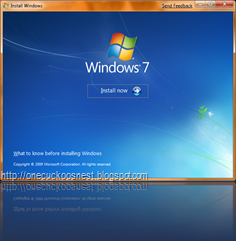 This is the first and last post on testing the Windows 7 Release Candidate. In short, excellent. I have had some issues with programs locking up at the save dialogue but besides that this is the best OS I have ever used. It is faster than my Vista install and even my install of Ubuntu Studio 9.04!
This is the first and last post on testing the Windows 7 Release Candidate. In short, excellent. I have had some issues with programs locking up at the save dialogue but besides that this is the best OS I have ever used. It is faster than my Vista install and even my install of Ubuntu Studio 9.04! So, to round up my time in this milestone of the OS, here is a small gallery of screenshots. It doesn’t cover everything by far, but it’s a little taste of the RC which is basically the same as the release version.
GO TO GALLERY
Friday, November 6, 2009
On A Friday: It's Just Not Cricket
When watching the Channel 10 Midday News last Wednesday (6th of November) I found my self, inevitably, watching a report on the cricket. The introduction to the report was along the lines of a player being sent home with an injury, and the replacements being replaced due to the replacements being injured. All clear, however I noticed in this introduction that the news reader did not once say the word "cricket." When the report started I started counting how many times the word "cricket" was said.
Actually, I didn't - "started" implies that I found at least one mention of the word. Yes, an entire cricket report without saying the word cricket once! Not just that, but there wasn't even the word cricket visible - no clear logo, nothing! On top of that is that there was only a very short clip of cricket actually being played - if you blinked twice (with each blink in immediate succession) you would have missed it! Anyone who only knew the game by sight or not at all would have been completely at a loss if they had missed this!
Goes to show that the society you live in has a massive influence in how you interpret what you hear and see.
What's On The Box?
Take a look - ABC 3 is not the ABC's first digital kids channel...
Most Popular This Week on OCSN
-
JOHN ROMERO, one of the developers of popular early 1990s PC game series Commander Keen , says he has found the source code for the Vorti...
-
This essay is intended to explore the influence of the British Empire on the thoughts and actions of former Melbourne Catholic Archbishop Dr...
-
In Windows 7, users of in-built card readers for cameras, mobile phones etc., can expect less logging off to re-gain access to their reader ...







 (0 Comments so far)
(0 Comments so far) 